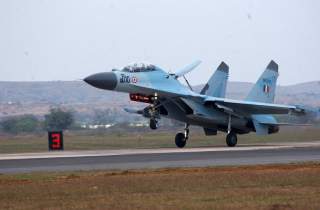Asia's "Cold Peace": China and India's Delicate Diplomatic Dance
President Xi Jinping just might have missed a golden opportunity to transform his nation's relationship with India.
One sign of how far China and India have yet to go as cooperative great powers is simply how they name and perceive their region. It was fascinating that neither country can yet find a way officially to define or recognize the other’s legitimate role in wider maritime Asia. Xi’s visit to India had come amid much fanfare about China’s concept of a “new maritime silk road,” which involves developing infrastructure for China’s seaborne commerce through Southeast Asia, across the Indian Ocean, and to Africa, the Middle East and beyond. Another way of terming this could be the Indo-Pacific or one of its variants, a framework which has caught on in India, Australia, Japan, Indonesia and parts of the U.S. policy community in recent years. Some Chinese commentary has begun to recognize that geo-economically these terms mean much the same thing.
But if there was any convergence of Chinese and Indian interests here, it was left publicly unsaid by the leaders. Little wonder, perhaps: for en route to India, Xi stopped by Sri Lanka and the Maldives, where China has outflanked India as a preferred investor in ports and airport facilities. Indian awareness of a military dimension to China’s long-term role in the Indian Ocean is no longer the stuff of “string of pearls” theories of a decade back. Evidence is mounting of China’s growing abilities and willingness to project military assets into these far seas, from submarine patrols, to surface taskforces, to counterpiracy, search-and-rescue and evacuation missions. India will need to find a way of working out which Chinese activities in its namesake ocean are legitimate—given China’s far-flung interests as a trading nation—and which warrant vigilance. In particular, India and others will need to be prepared for the moment when China starts making regular military use of civilian facilities along the maritime silk road, because it will quite naturally arrive.
For its part, China will need to accept that India likewise has a legitimate stake and role in the Pacific. Discouraging its partnerships with Japan, Vietnam or others will likely deepen them, unless China has game-changing reassurance to offer India that make them less necessary. If the recent announcement of up to $30 billion of Chinese investment in India was aimed at neutralizing Japanese inroads, it would have helped Beijing’s case it its officials had not earlier bragged about a figure three times as large.
It’s easy to call the Indian-Chinese relationship a rivalry, only it isn’t, not yet at least. These powers have not concentrated their efforts on a full-blown contest with one another. This is a deeply asymmetric relationship. India’s economy and military strength is a fraction of China’s, and the best India can hope for in strategic terms is a combination of resilience and deterrence: to protect its sovereignty and its interests from influence or potential coercion from its stronger neighbor. This helps explain both why India has a nuclear weapons program, and why it is not prosecuting it as if it were, yet, in an arms race. It also explains why India is increasingly interested in partnerships with regional middle powers, as well as with the United States.
The Indian-Chinese relationship can best be characterized as competitive coexistence or, as one expert has nicely put it, a cold peace, in which case things just got somewhat less cold, but also a little less peaceful. Whether competition or the coexistence comes to the fore—or indeed whether the relationship drifts towards conflict or evolves into genuine cooperation—will depend on the choices taken in both capitals in the years ahead. A generous appraisal of Xi and Modi would suggest they are like-minded technocrats, rightly impatient to strengthen their economies and societies. Mountainside military maneuvers will only keep them from that lofty goal.
Rory Medcalf is director of the international security program at the Lowy Institute and a nonresident senior fellow in foreign policy at the Brookings Institution.

